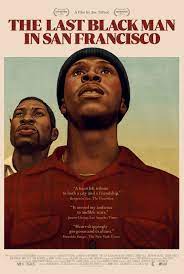
THE LAST BLACK MAN IN SAN FRANCISCO
US, 2019, 121 minutes, Colour.
Jimmie Fails, Jonathan Majors, Rob Morgan, Tichina Arnold, Mike Epps, Thin Wittrock, Danny Glover.
Directed by Joe Talbot.
This is very much a film made for audiences who have a liking for, a love for San Francisco. It is also a film made for African- American audiences, with most of the characters African- American and a focus on social issues.
The film was sponsored by the Sundance Institute and is very much a film geared for Film Festivals, arthouse release, the support of independent films. Which means that it has limited box office appeal, some audiences intrigued by the themes, the characters, the cinematography. Others have declared that they found it very boring and some have left the cinema. It is very much a film geared towards American interests in sensibilities – which may mean that it is “observed” by non-American audiences, rather than enjoyed.
Some have remarked that the film is something like a cinema poem on. There is something of a narrative but it is rather episodic, the film focusing on dialogue, on the visual imagery. And, San Francisco itself, become something of a character in the film, not so much the familiar vistas of the city but rather the streets, the Bay, the naval warehouses, suburbs and all dimensions with elegant interiors, other suburbs and older houses.
The audience is invited to accompany the central character, Jimmie Fails (which is, in fact, the name of the actor portraying him). He takes on jobs, walks the city, is rather morose in his look and manner, teams up with a friend, Mont (Jonathan Majors) who is something of a poet and playwright, always with his notebook for jotting. In a lot of sequences, the camera stays with them as they observe the city, a soap box preacher invading against evil is, sharing a scooter ride around the city.
Jimmie stays with his friend Mont, sleeping on the floor his room, sharing the house with Mont’s grandfather played by Danny Glover. In fact, there are a number of prominent American actors in cameo roles including Mike Epps and Rob Morgan as Jimmie’s father.
Key to the story is a mansion which Jimmie claims was billed by his grandfather in 1946. Jimmie and Mont want to squat there, redecorating the house, Jimmie painting outside schools and being warned off by very angry white woman whom he later encounters. They invite one of their friends to a meal and share the sauna. He belongs to a group that hang out in the street, seemingly idle, seemingly angry, one of them shot.
Commentators note the theme of gentrification of cities. The mention is for sale, Mont makes enquiries of the agent and discovers that the buildings from the 19th century. He writes a play, invites Jimmie and relatives and friends to the performance the combination of which is to inform Jimmie that the house was not built by his grandfather.
This has devastating impact on Jimmie, but he eventually seeks out Mont and reconciles with him, returning to his house. However, he disappears during the night, leaving a note expressing that Mont was his best friend. Mont then retraces areas that they shared together, eventually to the Bay front.
The film is certainly challenging to watch, to resonate with the themes, to empathise with the characters.